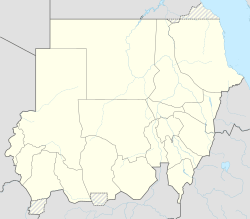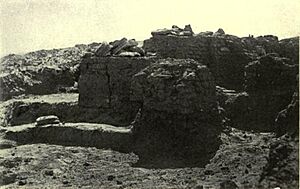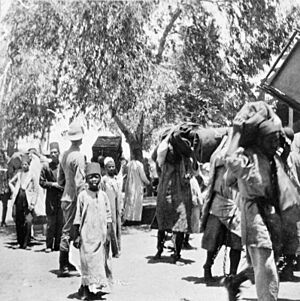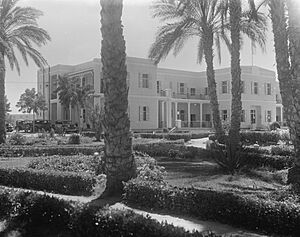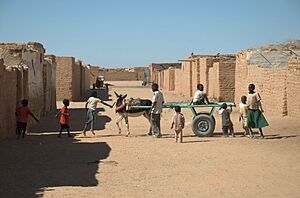Wadi Halfa facts for kids
Quick facts for kids
Wadi Halfa
وادي حلفا
|
|
|---|---|
|
City
|
|
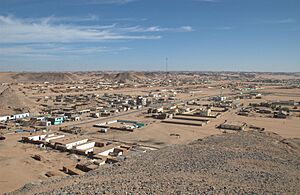 |
|
| Country | |
| State | Northern |
| Population
(2007)
|
|
| • Total | 15,725 |
Wadi Halfa (which means "Esparto Valley" in Arabic) is a city in the Northern part of Sudan. It sits on the edge of Lake Nubia, very close to the border with Egypt.
This city is a key stop for travel and trade. It's the end point for a rail line coming from Khartoum. Here, goods are moved from trains to ferries that travel across the lake. In 2007, about 15,725 people lived in Wadi Halfa. The city is surrounded by many ancient Nubian historical sites. Many archaeologists worked here to save these old treasures from being flooded when the Aswan Dam was built.
Climate and Weather
Wadi Halfa has a very hot desert climate, like what you'd find in the Nubian Desert. It gets an amazing amount of sunshine each year, almost 97–98% of all possible daylight hours! It also gets very little rain, usually less than half a millimeter (0.5 mm) per year. Many years pass without any rain at all.
The city has long, hot summers and short, warm winters. The average temperature for the whole year is around 27°C (81°F). From May to September, the daily high temperatures are often over 40°C (104°F). The amount of water that evaporates from the ground and plants here is also very high, about 5,930 mm (233 inches) each year.
| Climate data for Wadi Halfa (1991–2020 normals, extremes 1961–2020) | |||||||||||||
|---|---|---|---|---|---|---|---|---|---|---|---|---|---|
| Month | Jan | Feb | Mar | Apr | May | Jun | Jul | Aug | Sep | Oct | Nov | Dec | Year |
| Record high °C (°F) | 37.0 (98.6) |
41.6 (106.9) |
45.5 (113.9) |
47.0 (116.6) |
49.5 (121.1) |
48.7 (119.7) |
47.5 (117.5) |
47.6 (117.7) |
46.5 (115.7) |
45.0 (113.0) |
39.0 (102.2) |
36.0 (96.8) |
49.5 (121.1) |
| Mean daily maximum °C (°F) | 23.5 (74.3) |
26.2 (79.2) |
30.7 (87.3) |
36.0 (96.8) |
39.9 (103.8) |
41.4 (106.5) |
41.6 (106.9) |
41.7 (107.1) |
39.9 (103.8) |
36.6 (97.9) |
29.6 (85.3) |
24.8 (76.6) |
34.3 (93.7) |
| Daily mean °C (°F) | 17.2 (63.0) |
19.3 (66.7) |
23.4 (74.1) |
28.3 (82.9) |
32.4 (90.3) |
33.9 (93.0) |
34.2 (93.6) |
34.8 (94.6) |
33.2 (91.8) |
30.1 (86.2) |
23.5 (74.3) |
19.1 (66.4) |
27.5 (81.5) |
| Mean daily minimum °C (°F) | 10.9 (51.6) |
12.4 (54.3) |
16.1 (61.0) |
20.6 (69.1) |
24.9 (76.8) |
26.5 (79.7) |
26.8 (80.2) |
27.9 (82.2) |
26.5 (79.7) |
23.5 (74.3) |
17.4 (63.3) |
13.4 (56.1) |
20.6 (69.1) |
| Record low °C (°F) | 3.5 (38.3) |
2.5 (36.5) |
6.0 (42.8) |
10.5 (50.9) |
13.4 (56.1) |
15.5 (59.9) |
18.5 (65.3) |
17.8 (64.0) |
17.4 (63.3) |
12.3 (54.1) |
5.2 (41.4) |
2.0 (35.6) |
2.0 (35.6) |
| Average precipitation mm (inches) | 0 (0) |
0 (0) |
0 (0) |
0 (0) |
0 (0) |
0 (0) |
0.1 (0.00) |
0.5 (0.02) |
0 (0) |
0 (0) |
0 (0) |
0 (0) |
0.6 (0.02) |
| Average precipitation days (≥ 1.0 mm) | 0 | 0 | 0 | 0 | 0 | 0 | 0 | 0.1 | 0 | 0 | 0 | 0 | 0.2 |
| Average relative humidity (%) | 42 | 36 | 28 | 23 | 21 | 22 | 24 | 24 | 26 | 30 | 39 | 45 | 30 |
| Mean monthly sunshine hours | 306.9 | 277.2 | 306.9 | 303.0 | 319.3 | 333.0 | 341.0 | 328.6 | 306.0 | 313.1 | 306.0 | 328.6 | 3,769.6 |
| Source: NOAA | |||||||||||||
History of Wadi Halfa
People have lived in the Wadi Halfa area for a very long time. During the Middle Kingdom of Egypt, there was an Egyptian settlement called Buhen across the river. This settlement lasted until the Roman times.
The modern town of Wadi Halfa started in the 1800s. It became an important port on the Nile River for steamboats coming from Aswan. During the Turko-Egyptian conquest of 1820, Wadi Halfa was a stopping point for soldiers heading south. Communication improved in the late 1800s. A telegraph line to Egypt was set up in 1866. There were also attempts to build a railway to Kerma in 1873 and 1877. When the Sudanese railway finally reached Wadi Halfa, it became a major hub. Goods could be transferred from the railway to steamers that connected to the Egyptian railway network. This made Wadi Halfa more important than the older trade route at Korosko.
In 1885, Wadi Halfa faced a difficult time during the Mahdist War. There were often fights near the border. In 1889, an army led by Abd al-Rahman al-Mahdi passed through the town on their way to the Battle of Toski. For a short time, Wadi Halfa was the main base for British and Egyptian forces. These forces were led by Kitchener and were trying to defeat the forces of Muhammad Ahmad, who was known as the Mahdi. The railway line along the Nile was started in 1897 to help with this military effort. It now goes through Atbara all the way to El Obeid and further into southern and western Sudan.
A station that measured the river's water levels operated in Wadi Halfa from 1911 to 1931. It helped keep track of changes caused by the Aswan reservoir. Later, from 1931 to 1962, this station moved to Kajnarty, which is 47 kilometers north of the town. A hotel for railway travelers was built in Wadi Halfa during the 1900s. During World War II, Wadi Halfa was an important communication center for the Allied forces in Africa. By 1956, the town had grown to about 11,000 people.
On November 8, 1959, an agreement was signed between Sudan and Egypt about the Nile River's water. This agreement led to a big discussion because it meant the area would be flooded when the Aswan Dam was completed. About 52,000 people living there would need to move over four years, starting in 1960. The Nubian people were most affected. They protested in Wadi Halfa on October 23–24, 1960, because they didn't want to be moved. More protests happened in Khartoum, the capital of Sudan, which police had to stop with tear gas. The government quickly tried to calm things down. They put Wadi Halfa under special military rule and cut off communication with the rest of the country. Protests in Khartoum, mainly by students, led to the temporary closing of the Khartoum campus of Cairo University and about 50 arrests.
The old town of Wadi Halfa was completely destroyed by flooding in 1964 after the Aswan High Dam was built. Most of the town's people were moved to a new location. By 1965, the population of New Halfa was only 3,200. In the 1970s, archaeologists worked hard in the area to protect ancient Nubian monuments from the rising waters.
Wadi Halfa was shown in a TV show called Pole to Pole by Michael Palin in 1992. It was featured in part four, called "Shifting Sands." In 2005, there were plans to build a museum and a Nubian village in Wadi Halfa, but by 2014, these plans had not yet happened.
Economy
Farming is a very important part of the local economy in Wadi Halfa. Also, Chinese investors have built a factory in the town that processes fish.
Transportation
The Cairo-Cape Town Highway, a major road that crosses Africa, goes through Wadi Halfa.
In 2012, Sudan and Egypt agreed to finish building a standard gauge railway line between Aswan and Wadi Halfa. However, progress on this railway was stopped by civil unrest in Sudan in 2023.
See also
 In Spanish: Wadi Halfa para niños
In Spanish: Wadi Halfa para niños


